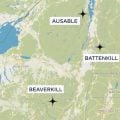Tanker Accident on West Creek
A tanker spill in western Colorado has Parks and Wildlife biologists and wildlife managers at work assessing damage incurred to streamside vegetation and fish populations.
Read more in the press release below.
Tanker Accident on West Creek
GATEWAY, Colo. – Colorado Parks and Wildlife biologists and wildlife managers responded quickly to the scene of a tanker accident on Highway 141 in West Creek near Gateway Jan. 25, to begin a thorough assessment of impacts to aquatic wildlife. In the days since the accident, agency personnel from the northwest and southwest regions of the state have recovered a large number of dead fish including brown and rainbow trout, sculpin and crayfish.
According to a spokesman from the Grand Junction Fire Department, the tanker was carrying 6000 gallons of gasoline and 2000 gallons of diesel fuel. After it left the highway and landed in West Creek, the tanker ruptured and caught fire. An unknown quantity of petroleum product spilled into the water and the fire destroyed vegetation for several hundred yards along the creek’s banks.
“Based on what we have seen so far, it appears the dead aquatic wildlife in West Creek experienced severe stress, likely from a combination of the petroleum product in the water and the extreme heat from the fire,” said Senior Aquatic Biologist Sherman Hebein of Grand Junction.
Approximately two hours after the incident, CPW personnel began to inspect the area. They detected a strong smell of petroleum product in the water several miles downstream from the accident, observed a visible, petroleum sheen on the water’s surface and discovered numerous dead and dying fish.
Agency personnel have returned to the site in the days after the accident and will continue assessing the full impact of the spill and fire in the weeks and months ahead.
Actual counts of recovered dead fish and records of fish population estimates previously performed by agency biologists will determine the total number of fish killed in this incident.
“The public is understandably concerned about this fishery,” continued Hebein. “Once we are satisfied with the clean-up and restoration of this stretch of the creek, our goal will be to restock it and return the area as close to its previous state as possible.”
Colorado Parks and Wildlife works with other state and federal agencies to determine the scope and severity of hazardous material spills that impacts wildlife. The agency is authorized to assess and collect fines for the loss of wildlife associated with such incidents.
For more information about fishery management, please visit: http://wildlife.state.co.us/Fishing/Management/ManagementandSurveys/Pages/FisheryWaterSummaries.aspx
Colorado Parks and Wildlife manages 42 state parks, more than 300 state wildlife areas, all of Colorado’s wildlife, and a variety of outdoor recreation. For more information go to cpw.state.co.us
For more information about Division of Wildlife go to: http://wildlife.state.co.us.
Limited Edition Shirts from TrueFlies
Report Examines Saltwater Fisheries Fund Allocations











